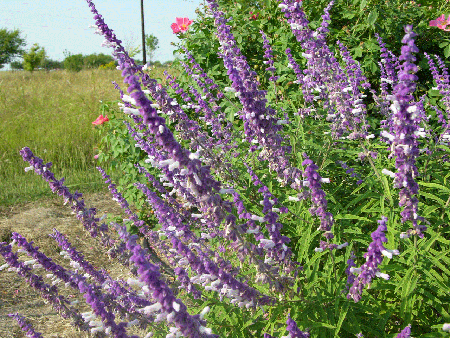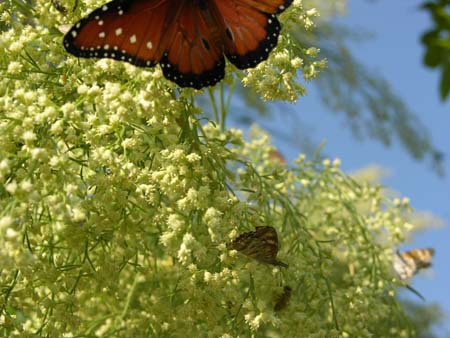
Hummingbird Hill specializes in plants that 1. Grows well here. 2. Has easy maintenance. 3. Has fragrance. 4. Looks pretty. 5. Draws butterflies and birds.
I do collect plants without fragrance, too, however. Here's one below.
I am always on the lookout for plants that have most of these attributes. So far I have discovered many that have all of them! I am passionate about collecting landscape roses, and German Iris.
Mexican Bush Sage (Salvia leucantha)
I do collect plants without fragrance, too, however. Here's one below.
I am always on the lookout for plants that have most of these attributes. So far I have discovered many that have all of them! I am passionate about collecting landscape roses, and German Iris.
Mexican Bush Sage (Salvia leucantha)
This one has no fragrance, but if you don't have this in your garden you are missing out. Mexican Bush Sage in full bloom is so beautiful, and the flowers are as soft and furry as a kitten. They are very drought hardy. Mexican Bush Sage blooms in the fall when the roses come back into bloom, and the purple color compliments beautifully with orange and yellow roses. The only drawback is that they are rather brittle and the stalks break easily. But the nice thing is that they also root easily, and so I just stick the broken stalks in my nursery area and keep them wet. Soon I have more Mexican Bush Sage to plant somewhere new.
The backbone of the gardens at Hummingbird Hill are native and adapted plants such as wildflowers, cacti, prairie grasses, shrubs and trees. These take longer to establish, but they are coming along nicely. You'll just have to come and see for yourself how quickly a garden like this can be established where the growing season is long and the winters mild; where the ground almost never freezes and the roots of things can go on growing all year around.
Here's a common little native tree that grows in Texas so fast that you can almost see it happen. You'll find it all along the bottoms along creeks, and disturbed pastures. I've had the dickens of a time identifying this tree that grows everywhere here. It is Baccharis neglecta, commonly known as "Poverty Bush" or "False Willow". It has male and female trees, like the Cottonwood tree, and the seeds are windblown. Therefore, like the dandelion, it sprouts up everywhere it can catch hold in disturbed soil. It is used by migrating butterflies by the droves because it blooms when they are migrating in the autumn. Therefore, find a grove in the fall when it is in bloom to let the children wonder at all the Monarchs feeding amongst the blooms.
The backbone of the gardens at Hummingbird Hill are native and adapted plants such as wildflowers, cacti, prairie grasses, shrubs and trees. These take longer to establish, but they are coming along nicely. You'll just have to come and see for yourself how quickly a garden like this can be established where the growing season is long and the winters mild; where the ground almost never freezes and the roots of things can go on growing all year around.
Here's a common little native tree that grows in Texas so fast that you can almost see it happen. You'll find it all along the bottoms along creeks, and disturbed pastures. I've had the dickens of a time identifying this tree that grows everywhere here. It is Baccharis neglecta, commonly known as "Poverty Bush" or "False Willow". It has male and female trees, like the Cottonwood tree, and the seeds are windblown. Therefore, like the dandelion, it sprouts up everywhere it can catch hold in disturbed soil. It is used by migrating butterflies by the droves because it blooms when they are migrating in the autumn. Therefore, find a grove in the fall when it is in bloom to let the children wonder at all the Monarchs feeding amongst the blooms.
Queen and Meadow Argus butterflies feed amongst the flowers with the honey bees.
This willow-like tree in bloom is an insect smorgasbord. It is a pretty tree and very drought hardy. The only drawback to them is that they are very invasive. But, walking through a grove in bloom is wonderful. The sweet smell exudes all around, and suddenly you see that you are in butterfly world! These trees fill the creek bottoms around here, but how many of you have actually walked through them in the fall when they bloom? It's an amazing sight. That is why I allow some to grow near my house, just so I can smell the fragrance and hear the plant buzzing with excited insects when it blooms.
My mantra: A garden should be filled with plants that blow in the wind, buzz with happy insects, smells good, nests birds, looks pretty, and has little maintenance. It is these things that bring a garden to life. This little tree fulfills all those nice attributes.
Some other plants that I've been delighted with are:
All different types of basil,
Purple coneflowers (Echinachea) with fragrance,
Agastache.
This willow-like tree in bloom is an insect smorgasbord. It is a pretty tree and very drought hardy. The only drawback to them is that they are very invasive. But, walking through a grove in bloom is wonderful. The sweet smell exudes all around, and suddenly you see that you are in butterfly world! These trees fill the creek bottoms around here, but how many of you have actually walked through them in the fall when they bloom? It's an amazing sight. That is why I allow some to grow near my house, just so I can smell the fragrance and hear the plant buzzing with excited insects when it blooms.
My mantra: A garden should be filled with plants that blow in the wind, buzz with happy insects, smells good, nests birds, looks pretty, and has little maintenance. It is these things that bring a garden to life. This little tree fulfills all those nice attributes.
Some other plants that I've been delighted with are:
All different types of basil,
Purple coneflowers (Echinachea) with fragrance,
Agastache.
These plants are just great for this climate, and there are so many more I want to experiment with that I feel thrilled in anticipation of it all.
A garden is an evolution of delightful surprises, a few disappointments, and is always changing. For me, that sort of sums up life.
A garden is an evolution of delightful surprises, a few disappointments, and is always changing. For me, that sort of sums up life.






